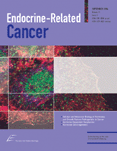| HOME | HELP | FEEDBACK | SUBSCRIPTIONS | ARCHIVE | SEARCH |
|
|
||||||||
| ||||||||||||||||||||||||||||||||||||||||||||||||||||||||||||
REVIEW |
H Timmers, Department of Endocrinology (741), Radboud University Nijmegen Medical Center, Nijmegen, 6511BM, Netherlands
A Gimenez-Roqueplo, service de Genetique, Assistance Publique-Hppitaux de Paris, Hopital europeen Georges Pompidou, Paris, France
M Mannelli, Endocrinology Unit, Department of Clinical Physiopathology, University of Florence, Florence, Italy
K Pacak, Reproductive and Adult Endocrinology Program, National Institutes of Health, Bethesda, United States
Correspondence: Henri Timmers, Email: h.timmers{at}endo.umcn.nl
Abstract
Paragangliomas derive from sympathetic chromaffin tissue in adrenal and extra-adrenal abdominal or thoracic locations, or from parasympathetic tissue of the head and neck. Mutations of nuclear genes encoding subunits B, C and D of the mitochondrial enzyme succinate dehydrogenase (SDHB 1p35-p36.1, SDHC 1q21, SDHD 11q23) give rise to hereditary paraganglioma syndromes PGL4, PGL3 and PGL1, respectively. The susceptibility gene for PGL2 on 11q13.1 remains unidentified. Mitochondrial dysfunction due to SDHx mutations have been linked to tumorigenesis by upregulation of hypoxic and angiogenesis pathways, apoptosis-resistance and developmental culling of neuronal precursor cells. SDHB-, SDHC-, and SDHD-associated paragangliomas give rise to more or less distinct clinical phenotypes. SDHB mutations mainly predispose to extra-adrenal, and to a lesser extent, adrenal paragangliomas, with a high malignant potential, but also head and neck paragangliomas. SDHD mutations are typically associated with multi-focal head and neck paragangliomas and usually benign adrenal and extra-adrenal paragangliomas. SDHC mutations are a rare cause of mainly head and neck paraganglioma. Most abdominal and thoracic SDHB-paragangliomas hypersecrete either norepinephrine, or norepinephrine and dopamine. However, some hypersecrete dopamine only, or are biochemically silent. The biochemical phenotype of SDHD- paraganglioma has not been systematically studied. For the localization of paraganglioma, several positron emission tomography tracers are available. Metastatic SDHB- paraganglioma is best localized by [18F]-fluorodeoxyglucose positron emission tomography.
This article has been cited by other articles:
 |
E. Thouennon, A. Pierre, Y. Tanguy, J. Guillemot, D.-L. Manecka, M. Guerin, L. Ouafik, M. Muresan, M. Klein, J. Bertherat, et al. Expression of trophic amidated peptides and their receptors in benign and malignant pheochromocytomas: high expression of adrenomedullin RDC1 receptor and implication in tumoral cell survival Endocr. Relat. Cancer, September 1, 2010; 17(3): 637 - 651. [Abstract] [Full Text] [PDF] |
||||
 |
S. G. Waguespack, T. Rich, E. Grubbs, A. K. Ying, N. D. Perrier, M. Ayala-Ramirez, and C. Jimenez A Current Review of the Etiology, Diagnosis, and Treatment of Pediatric Pheochromocytoma and Paraganglioma J. Clin. Endocrinol. Metab., May 1, 2010; 95(5): 2023 - 2037. [Abstract] [Full Text] [PDF] |
||||
| HOME | HELP | FEEDBACK | SUBSCRIPTIONS | ARCHIVE | SEARCH |